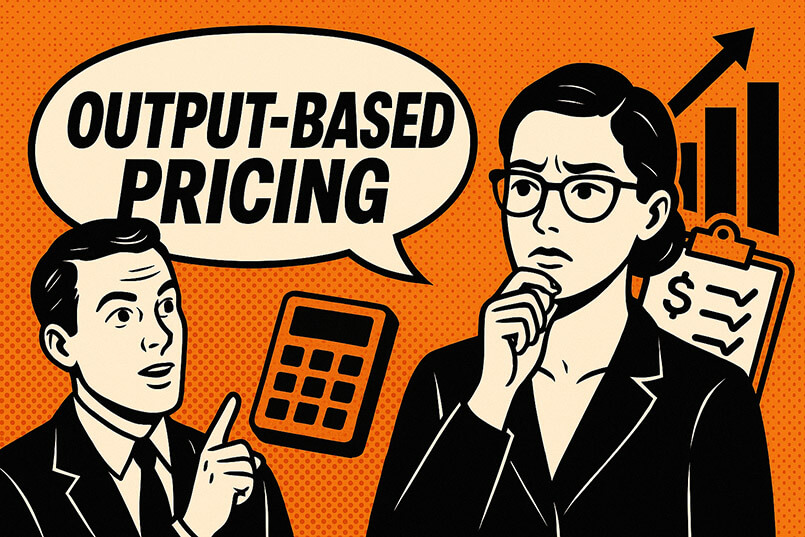The past 18 months or so have seen more advertisers and agencies looking to move away from “traditional” FTE/resource/cost-recovery-based pricing models to something more sustainable. The rise of generative AI threatens to eat into labour-based income streams for agencies, and advertisers are continually searching for cost savings while still seeking high-quality strategic and creative leadership from agency partners. The answer: “value-based” pricing.
There is considerable content available from various practitioners and consultancies purporting to help the move to a value-based approach. In my former career as an agency CFO, I sought out and digested as much information as possible; philosophically, it all made sense, but practically was useless. And this was just the agency side – for marketers looking to implement a value-based model, there is very little guidance out there, and both agencies and marketers usually end up putting it in the too-hard basket.
So, Darren Woolley, TrinityP3 CEO & founder, and I sat down recently to discuss the subject from both perspectives to try and demystify the problems and provide answers to some of the issues. You can find that podcast episode here. This article, the first of two on the subject, will elaborate on some of the perceived obstacles to introducing a value-based model and what can be done to overcome them, and the next article will provide some practical advice on how to put this system into place.
The first question that needs to be asked is:
What is value-based pricing? (And what is it not?)
The biggest mistake is to assume value-based pricing should be aligned with advertiser performance; that is, pay the agency based on the commercial outcomes related to the advertising – the “value added” to the advertiser’s business. The problem here basically comes down to the “risk” vs. “reward” equation; unless you’re prepared to pay the agency a significant premium for the services considered if your commercial outcomes are favourable, the risk for the agency is too great if they’re not.
That doesn’t mean you can’t include a performance element in the contract. Performance-based remuneration still has its role in incentivising agency behaviour, but the agency should be paid a fair market price as its base fee.
Put simply, value-based pricing is the price paid for delivering a service or output from the agency, where the “value” is defined as the benefit the buyer (advertiser) derives from receiving that service or output. The benefit can be real but is most commonly perceived by the buyer.
An example of a “high” value service or output could be the strategic thinking and insights for your marketing programme the agency delivers.
An example of a “low” value service or output may be quick turnaround and short-life content production to appear in your owned social media channels.
Or the high and low examples might be the other way around: your business may view content creation as highly valuable and important to your organisation and have less interest in insight generation.
“Value” is specific to the buyer and the context in which it’s being considered; one advertiser’s trash is another advertiser’s treasure.
Now let’s move to some of the common obstacles we see for both Agencies and Advertisers and the reasons they shouldn’t hold you back from moving to value-based pricing.
Where Agencies Struggle
Going from certainty to uncertainty.
For the best part of 30 years now, FTE or resource-based cost recovery models have dominated agency remuneration. By applying a relatively consistent overhead and profit mark-up to staff costs and turning that into an hourly rate, agency CFOs can reliably estimate what their agency’s income is likely to be, particularly with retainer style arrangements; each client paying roughly the same amount for the same Scope of Services and Work as the next client.
Shifting to a system where what each client pays may vary significantly for similar services (based on each client’s perceived value) means less certainty.
However, agencies have been dealing with this more and more in recent times anyway, as retainers give way to one-off campaign and project fees – value pricing is just the next step in that evolution and should be seen as an opportunity to finally justify a commensurate fee for the higher value services (usually strategy & creative concepts, and in the media sphere strategy and channel planning), and charge an appropriate fee for the lower value services rather than treating both equally as a cost recovery exercise.
Signalling the death knell for retainers.
Related to the first point, agencies continue to offer “all you can eat” retainers, where the remuneration is driven by selling hours rather than what is delivered, to try and hold onto guaranteed monthly cash flow.
But “retainers” don’t necessarily have to follow the traditional approach. We recently installed a value-based model for an advertiser that paid the agency the annual budget in 12 equal monthly instalments. Each output or deliverable was assigned a pre-determined price (negotiated based on value to the client), and the agency provided a monthly reconciliation of the total price of the projects briefed versus the budget they had already received; the agency maintains its cash flow and the client in return receives a detailed report of where and on what their money was spent.
Not wanting to miss out because of price in competitive tenders.
Another reason both agencies and advertisers prefer hourly rate cards is they are easily comparable. While this is somewhat true (“Title Creep” is perhaps a topic for another day), agencies feel they can put their best foot forward by discounting their rate card (usually in proportion to how desperately they want the business) or at least make for a relatively objective negotiation.
It is more difficult to assign a price to an output or service when the agency may not fully comprehend (yet) the value the advertiser ascribes to that function.
However, in our experience, a well-run agency search and selection process generally sees the 1 or 2 agencies the advertiser deems best fit for them being taken through to the final stage, where most proposals are negotiable. The least expensive agency never gets to the pointy end of the process just because they were the cheapest option – quite often, it’s the opposite, and negotiation takes place to better align the client’s perception of value with the price proposed.
Not knowing where the value exists.
This is also related to the previous point; quite often, the agency doesn’t understand or hasn’t taken the time to explore what the advertiser finds valuable, and the subsequent quote or proposal doesn’t match the client’s perception of value.
We had a multi-brand client who used one agency to provide strategy, creative, and production services for all the brands in the client’s portfolio. Each brand was at a different point in life: older, legacy brands with a low market share and little scope for growth received minimal marketing investment; newer products and brands with significant upside potential received the lion’s share of the budget.
Yet, the agency charged the same “rates” and, therefore, the price for the same services to every brand, citing the rationale that it takes the same amount of time to make, let’s say, an OOH campaign for the old legacy brand as it does the new challenger brand.
This disconnect frustrated the CMO so much they pitched the business. If the agency had simply recognised the lower-value brands warranted lower pricing, they may have kept the business. To be fair, the agency had considered this but didn’t raise it with the client because they thought it would mean a “discount” across the board. The client subsequently told us they were happy to pay a premium for the high-value brands because the agency’s strategy and creativity were highly regarded but couldn’t justify the premium for those brands on the decline.
Where Advertisers Struggle
Fear of not getting the contribution of key talent on their business.
Often, advertisers will select an agency based on specific people who have presented throughout the pitch process they feel are key to a successful partnership.
An agency retainer is often structured to include the requisite number of hours of these key personnel that the client deems is needed to service their business adequately and has it written into the contract to ensure the agency is held to account for providing said number of hours.
Move to a value-based system where there is no such “guarantee” in place (the number of hours isn’t part of the pricing structure), and the fear is those key personnel will be swallowed up by other clients and not contribute to “my” business.
The reality is that even under the head hours system, that fear has always been a possibility. Agencies have always oversold their best people’s time across many clients; agency timesheets have always been an approximation of the facts and not necessarily representative of what you’re getting; and perhaps most obviously – people move on to other jobs!
The best agencies work as a team; yes, you may have been particularly impressed by the Strategy Director’s presentation and understanding of your problem, and they probably are really, really clever, but they were likely supported in those findings by numerous people behind the scenes, and that is what you’re paying for a solution to the problem, not just one individual’s contribution to that solution.
Fear of a “transactional relationship” with the agency.
The worry here is also related to the last point: “If I’m moving to a value/output-based model, then the agency is only going to focus on what I brief them – not come up with proactive ideas to help my business”.
But the agency is likely doing this under the FTE-based model too. Usually, the only times the agency starts presenting proactive ideas is when there are unutilised hours to soak up in the retainer, so they don’t have to give money back at the end of the year reconciliation. (How many of those ideas are any good?)
At the other end of the spectrum, all too often in my days as an agency CFO, the team would come up with a viable proactive idea only to be told: “That’s not in our marketing plan”, or most commonly, “we don’t have any budget for that”. If you want your agency to think about your business 24/7, make it clear that there is a significant budget outside of the set Scope of Work to bring to life good ideas that you think are of value to the business.
Not knowing where the value exists.
Yep, I alleged agencies don’t always understand this, but often, neither do some advertisers know their own portfolios well enough.
I remember a single brand retailer whose C-Suite insisted the marketing budget and efforts be split by state, based on population (apparently, the CFO’s “activity-based costing” system was set up that way, and all costs needed to be apportioned by the same method). Ignored was the fact that the biggest states had already maxed out their market share, and the smaller states with the biggest growth potential weren’t allocated enough budget to move the needle significantly.
In the next article, we’ll look at some methods you can use to implement agency fees using value-based pricing practically.
Contact us if you have successfully moved to value-based pricing or are looking to. We’d love to hear your thoughts on the subject. Or learn more about our approach to Agency Commercial Evaluations, including Agency Fee Modelling and Agency Fee Benchmarking.




